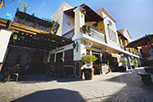MEDICAL DESTINATIONS IN MEXICO
BAJA CALIFORNIA
TAMAULIPAS
QUINTANA ROO
LOCATIONS IN BAJA CALIFORNIA
ACROSS FROM CALIFORNIA & ARIZONA
WHY CHOOSE BAJA CALIFORNIA?
Sharing a border with both California and Arizona, Baja for decades has been a magnet for tourists seeking immersion in a different culture, outdoor adventures, fine food, plus breathtaking scenery and natural resources.
Together, California and Baja California combine for one of the most dynamic border regions in the world.
With tens of thousands of retirees from the U.S., Canada and other countries now living in this beautiful state, Baja also has developed infrastructures for both extended care and senior living services.
Baja California is the Culinary Capital of Mexico, “Most Innovated gastronomic activity in Latin America”. 32% of all tourists come for its culinary movement and Mexicali offers some of the best dishes. Baja’s Wine Route was nominated for “Best International Food & Wine Route”, with more than 150 wineries, more than 750,000 annual visitors and 24 million bottles, Baja produces 90% of all Mexico’s wine. Baja California has also 83 breweries that produces 80% of Mexico’s craft beers and has won “Best Craft Beer of Mexico”, five years in a row. Already a world-class tourist destination, Baja has the infrastructure and experience in place to be a welcoming host to medical tourists.
With wonderful hotels inns set amidst soothing seas and tranquil deserts between the Sea of Cortez and the Pacific Ocean, Baja is the perfect place to stay while awaiting a medical procedure or recuperating from one.
With leading-edge technology and state-of-the art facilities, Baja’s medical and dental centers treat patients from all over the world. Baja welcomes more than one million visitors a year for an extensive range of medical specialties and services, a number that is growing rapidly.
Los Algodones
#1 Dental Tourism Denstination
"Bienvenidos
We invite you to Discover all BAJA California"


The place with more dentists in the
world is located in northern México.
Mexicali
The capital of Baja


.jpg?crc=8499940)

Roughly 10,000 people visit Los Algodones, in the State of Baja California, next to the Colorado River, on the corner of California, Arizona and the Mexico/USA border.
Dental Tourism is the most important economic sector in Los Algodones and economic growth relies heavily on Medical Tourism. In recent years, this city has tremendously improved and has gained an international spotlight due to the cost and quality of services offered along with being able to provide treatments using leading edge technology.
Our doctors are affiliated with the Mexican and American Medical Associations, as well as, certified by the international health organizations. They provide medical attention faster in México than the U.S. or Canada. Our bilingual doctors accept American Health Insurance.
This small friendly city that has become the Dental Capital of the World, with handicamp ramps and easy access to walk around town, is designed for your care and safety and we are ready to receive you.
"Find a wide variety of high quality medical services in over 350 dental offices"
This innovative frontier city is specialized in your well-being
Mexicali offers visitors the options of crossing by vehicle or foot from neighboring Calexico in the U.S. The Capital of Baja is a city of about 1,000,000 people and is named by combining the words Mexico and California.
Medical tourists can save up to 80%, even after costs of travel and lodging are included.
You will find more than 20 specialized clinics to meet the needs of medical tourists:
Dental Services
Oncology
Cardiology
Orthopedics
Plastic & Cosmetic Surgery
Additional Specialties
Our "Medical Lane" will help save you time going back to the USA at the Calexico West International Border.
Call for packages and rates to
011 52 (686) 566-1116
Located just 31 miles from Mexicali, the capital city of Baja California.

MediPlaza is the place where you can find the best medical treatments in Mexico, including Stem Cells, Hyperbaric, Optical, Dental and Surgery Services.
Visit the traditional Chinese food or premium cuts of meat and enjoy a renovated hotel infrastructure that will make you feel at home.
5 Star Hotels in Mexicali
LOCATIONS IN TAMAULIPAS, MEXICO
ACROSS FROM TEXAS IN THE RIO GRAND VALLEY
It is bounded by the United States (Texas) to the north, the Gulf of Mexico to the east, and the states of Veracruz to the south, San Luis Potosí to the southwest and west, and Nuevo León to the west.
The central and southern portions of Tamaulipas are mountainous, but there are extensive, fertile plains in the north. The sandy, lagoon-dotted coastal zone is sparsely inhabited. The coastal plains along the Gulf have a large presence in the state, whereas inland the landscape is adorned by cactus species and pasture. Predominant fauna in the region include the cougar (Puma concolor), long-tailed weasel (Mustela frenata), ocelot (Leopardus pardalis), American badger (Taxidea taxus), North American beaver (Castor canadensis), plain chachalaca (Ortalis vetula) and quail. In the western part of the state, the Sierra Madre Oriental displays warm valleys and high sierras with peaks reaching10,760 ft in the Pedragoso Sierra; 10,630 ft in the Borregos Sierra; 10,560 ft in La Gloria Sierra; 10,430 ft in Cerro el Nacimiento; and 9,800 ft above sea level in the Sierra el Pinal. The Sierra de Tamaulipas and the Sierra de San Carlos are isolated mountain ranges in eastern Tamaulipas. The Río Grande river defines the Tamaulipas-Texas border, including a narrow strip of territory that extends northwestward between Nuevo León and Texas.
Tamaulipas, which is part of the fertile lowland area known as “La Huasteca,” has an ideal agricultural climate and is Mexico’s main producer of sorghum; other major crops are citrus fruits, cotton, and vegetables. Tamaulipas has more area of irrigated cropland than any other Mexican state and more than half the state’s land area is devoted to raising cattle, goats, pigs, and sheep. Tamaulipas’ prime location on the Gulf of Mexico makes it a center of the country’s fishing industry. The primary harvests include shrimp, crayfish, oysters and crabs. Freshwater fish such as tilapia and catfish are also abundant throughout the state. Tamaulipas also produces a large proportion of Mexico’s natural gas and significant quantities of petroleum.
The cross-border trade boom that began in the 1990s brought population growth to several cities on the border with Texas: Nuevo Laredo, Reynosa , and Matamoros. Other major centers are Tampico and Ciudad Madero, which adjoin on the Gulf coast.
The central zone contains the capital, Ciudad Victoria, and is home to much forestry and farming, as well as some industrial development. About 30% of the population lives here, both in the capital and in Ciudad Mante. Ciudad Victoria is the capital of the Mexican State of Tamaulipas. and lies in the western part of the state at 1,053 feet above sea level on the San Marcos River, about 300 miles north of Mexico City. A settlement was founded on the site in 1750, and in 1825 it was named for the first president of Mexico, Guadalupe Victoria. Ciudad Victoria is also a tourist center and a base for hunting, fishing, and swimming activities centered on Lake Vicente Guerrero, located about 30 miles to the northeast. The city has a cultural center with a library, theatre, and art gallery. Among the other cultural institutions are a museum containing exhibits on the Huastec culture and the state library, which is housed in a green-tiled building with Aztec motifs. Ciudad Victoria is a significant educational center, home to the Autonomous University of Tamaulipas (which also has campuses in other cities in the state), the Regional Technical Institute of Ciudad Victoria, the University of Valle de Bravo, and other institutions of learning. Ciudad Victoria is a regional transportation hub, accessible by railroad, air, and several major highways. The Tropic of Cancer crosses the southern part of the municipality of Victoria.
Matamoros, Tamaulipas is situated on the southern bank of the Rio Grande 28 miles from the Gulf of Mexico and across from Brownsville, Texas. Matamoros, founded in 1824, was the scene of bitter fighting in the Mexican-American War and was occupied by U.S. troops in 1846. The municipality of Matamoros features many historical buildings and attractions. The Main Square downtown is home to monuments honoring Miguel Hidalgo, founder of the Mexican War of Independence movement, and Benito Juárez, considered by many to be Mexico’s greatest leader. The Teatro de la Reforma (also called ”The Opera Theatre”) in Matamoros was originally built in 1865. In 1904, it witnessed a historical moment when Mexico’s national anthem was performed there for the first time by its composer, Don Jaime Nuño. The Cathedral of Nuestra Señora del Refugio, which was built in 1832, is another point of interest in the state. In 1958, Pope John XXIII created the new dioceses for Matamoros and designated the church as a cathedral. The Puerta Mexico, or New Bridge, inaugurated in 1928, connects Matamoros with the city of Brownsville, Texas. It is now one of Mexico’s chief ports of entry for tourists and for the import and export of goods. The manufacturing and commercial center of an extensive cotton- and sugarcane-growing area, it has tanneries, cotton mills, and distilleries.
Nuevo Laredo, city and port of entry, Tamaulipas lies along the Rio Grande, across from Laredo, Texas. The city serves as a commercial center for the regional cattle industry and as a natural gas production center. It is the site of numerous maquiladoras (foreign-owned manufacturing plants) that produce electronics and other consumer goods for export. As a major port of entry, Nuevo Laredo also provides a variety of products and services for tourists.
One of the most beautiful beaches along the Tamaulipas shoreline and an ideal spot for sport fishing is La Barra del Tordo. The Carrizal River meanders along the beach’s shores, forming a complex ecosystem with rich and abundant vegetation and fauna, including the Lora turtles that come to the beach every year to reproduce. Among the state’s more inviting beaches are Altamira and the Golden Dunes, located in Altamira, and Miramar, which draws countless visitors annually. Bagdad Beach, east of Matamoros, hosts the ever-popular El Festival del Mar (Festival of the Sea) each year.
Tampico’s historical downtown features architectural landmarks, such as the Cathedral of Tampico, the Maritime Customs Building, and Pirámide de las Flores (Flower’s Pyramid), that showcase the city’s culturally diverse past and attracts tourists from all over the world. Also of importance are the tourism and fishing industries, as well as much commercial shipping, based in Tampico and Altamira.
More then half of the state has a hot, sub-humid climate. In the center, north, and towards southwest, an arid and semi-arid climate is predominate. A temperate sub-humid climate is found in the extreme southwest of the state while in the extreme southeast, a hot, humid climate is present. Annual temperature in the state is around 74.3 °F while annual precipitation is 31 inches, mostly concentrated between June to September.
The little village of La Pesca, in the municipality of Soto La Marina, about midway between Brownsville, Texas and Tampico, is a rapidly growing tourist area with lovely beaches and excellent fishing both in the Gulf of Mexico and the Rio Soto La Marina.
There is much history and many attractions for tourists in the Mexican State of Tamaulipas as well as offering Americans and Canadians quality, low cost medical and dental services to 1000's of visitors who travel across the border to Matamoros, Reynosa and of course, the highly sought after, Nuevo Progreso.
Quintana Roo
is a Mexican state on the Yucatán Peninsula, the humid tropical climate is a haven for sun worshipers, adventure seekers and water enthusiasts.
MEDICAL DIRECTORY FOR
CANCÚN – PLAYA DEL CARMEN – CHETUMAL
Cancún
is the first tourism destination built in the early 70's and is now a large metropolitan city. The tourism zone is outside the main city center on a small peninsula that surrounds a natural lagoon. Cancún has a reputation as the "spring break haven," with long beaches and coral reefs.
Playa del Carmen
is the largest city in The Riviera Maya and is an 88 mile stretch along the Caribbean coastline. It's known for its numerous all-inclusive resorts, but with its growth and recent addition of art and cultural activities in the last few years, has maintained its small town feel where locals and visitors mix happily.
Chetumal
is the capital city of Quintana Roo, and is situated in the eastern Yucatán Peninsula, just north of the Belizean border. It was founded on the site of a former Mayan settlement at the mouth of the Hondo River on the Bay of Chetumal, an extension of the Caribbean Sea. A rather quiet city, close to three excellent Maya ruins, an amazing jungle and the border to neighboring Belize.
Medical or Health Tourism is one of the major motivators for
international travel that has been steadily increasing.
Cancun offers foreign tourists, especially from the United States and Canada, high-quality options for the treatment of diseases, surgery and preventive medicine. Offering a variety of professionals endorsed by their corresponding Colleges and Associations, all this with low-cost prices for the exchange rate of our currency against the dollar.
Traveling to another country to obtain adequate medical care has become a high-growth practice. If we also add the growing trend of taking advantage of these trips as an opportunity to enjoy a vacation, in one of the most visited favored destinations in the world, such as the Mexican Caribbean.
easily Find the best medical care ,
in the Cancun Medical Directory app.
The specialties most sought after by American patients are plastic surgery, particularly liposculpture, restorative or cosmetic dental treatments, bariatric surgery, orthopedic knee or hip replacement and fertility treatments, with costs up to 70% lower in Mexico than in the United States or Canada.
Medical Specialties
Choose Your Specialty; Cancun, Playa del Carmen & Chetumal
Ambulance Services - Cardiac & Thoracic Surgeon - Cardiologists - Chiropractors - Dental Surgeons- Dentists- Dermatologists - bariatric surgery - Emergency Medicines - Emergency Services - Gastroenterologists - Gynecologists & Obstetricians - Health & Beauty - Hematologists - Hospitals - Nephrologists - Neurologists - Neurosurgeons - Ophthalmology - Orthodontics - Orthopedics - Pathologists - Pediatrics - Periodontics - Drug Strore - Plastic Surgeons - Podiatrists - Prosthodontics - Psychiatry - Psychology - Pulmonologists - Radiologists - Reproductive Medicine - Surgeons - Urologists - Vascular Surgeons - Veterinary Clinics
Remember before you travel to Cancun, dont forget to
download the Cancun Medical Directory App
Play Store - Google Play
Download App DOCTORS IN CANCUN
Download App DOCTORS ON THE BEACH
Download App DOCTORS IN CHETUMAL
SHARE OUR WEBSITE












